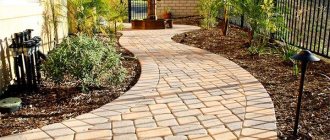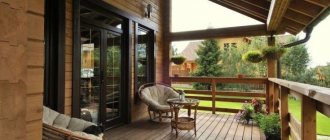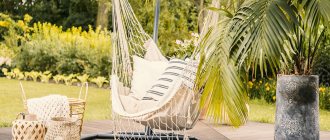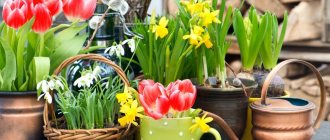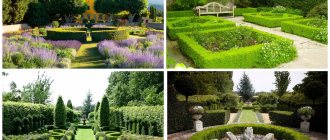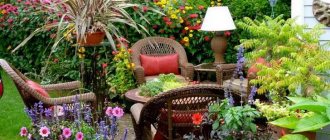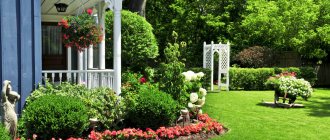Creating your own garden on your property and improving the surrounding area is a completely feasible dream for many amateur gardeners. But how to do this correctly, taking into account the standards of landscape design, is already a question that needs to be sorted out. The main criterion for garden design is its style. It is difficult to imagine a garden design without a clear understanding of the final goal, as well as a single line, technically correctly deployed at all stages of its creation.
Style is harmony, the right combination of individual elements used to create the integrity of the picture. Therefore, it is important to understand what the owner of the personal plot wants to see in the end, upon completion of the work. There are many styles of different directions, sometimes they are intertwined into a single whole, thereby creating a unique color ensemble. Each style has its own requirements for the materials and forms used. Each style is beautiful in its own way and reflects the inner world and preferences of the garden owner. This article presents the most common trends in landscape design, their features, and distinctive features.
Country (rustic) style
Naturalness, this is precisely the feature that characterizes the rustic Country style. Its diversity, priceless charm, warm simplicity are reflected in the traditions of different peoples. Country style is suitable for those who love simplicity, comfort, soft home peace, and practicality. To create a rural atmosphere in your garden plot, you will not need large financial investments; all materials used can be made from available materials.
Distinctive features of Country style
A distinctive feature of the Country style is that here you can apply the entire breadth of your imagination. Things that have already served their useful life are suitable for arranging a garden plot. These can be: wicker baskets, flower pots, clay pots hung on the fence. Vine and dry tree branches are well suited for creating fences and flower beds. For the arrangement of paths, natural stone, cobblestones, pebbles, and ceramic tiles are used. A wooden cart wheel, a working or decorative well will only emphasize the beauty of the design. Bright wooden benches, as well as small painted stools, would be appropriate next to an artificial pond overgrown with reeds.
The landscaping part of decorating a garden in a rustic style does not require any special effort; mainly trees and crops from the region where the owners of the plot actually live are planted in the garden area. Popular fruit trees include apples, pears, plums, cherries, and cherries. You can plant various shrubs, such as: rose hips, viburnum, sea buckthorn, lilac. It is also preferable to plant flowers native to the region in which they grow. For example, Russia is characterized by: asters, daisies, marigolds, mint, and various climbing plants that can perfectly decorate hedges or a gazebo.
IMPORTANT! When arranging a garden courtyard in a rustic style, you should adhere to a certain connection to a particular region. You should not mix the ethnicity and life of different nationalities; it is better to correctly maintain a single line.
What material should the flowerbed be made from?
When choosing a material for making flower beds, it is necessary to take into account all the nuances of their operation. For perennial plants that “overwinter” in the ground, you should not make concrete flower beds, since the soil in them is subject to greater freezing than in flower beds made of other materials.
Wooden flower beds may be the best option. Environmentally friendly natural material will help plants cope with winter more easily.
When creating flower beds from wood, they must be treated with an antiseptic, which will prevent damage to the flower bed.
The use of iron to create flower beds is justified by the fact that this material allows you to make various shapes, which is important when creating an original landscape design.
English style
The design of a garden plot in the English style does not imply clearly defined lines. All paths, flower beds and lawns have smooth outlines; there are no strict geometric shapes here. An English garden is made up of shady alleys, tall trees and fences covered with green shoots. The presence of a pond in the natural area of an English garden will add a certain charm to the design of a personal plot; ideas for its creation may be different.
Features of the English style
When designing a garden plot in the English style, certain elements and techniques of landscape design are used that help create a natural landscape in the area. To achieve the best result, especially prominent decorative elements are masked with hedges of plants or hidden behind green spaces. The above diversionary move is necessary to create a unified concept, as well as achieve some kind of balance. All paths, flower beds, arches, gazebos, along with green spaces, create a single integrity of the picture, with pleasant soft outlines and shapes.
It is not difficult to carry out an English site design. First, you need to decide where the formal and natural areas will be located. The formal area is designed for relaxation, with benches, statues and fountains, and winding cobblestone paths to complete the overall look. Part of the natural landscape does not imply the installation of large decorative elements. Objects that do not stand out from the general plan may be located here. A small bridge spanning an artificial pond made of stone will look especially good.
French style garden
Under the name “French style” hides a whole group of subvarieties: “Provence”, and “Mediterranean”, and, of course, the classic one mentioned above. Let us dwell in more detail on the variety of French landscape design called “Provence”.
The main elements of a French garden (Provence):
- small and cozy rectangular lawn;
- an abundance of fruit and ornamental trees;
- mini-garden in high beds;
- abundance of natural materials in decoration, especially sandstone and red brick;
- climbing roses and herbs;
- low curbs along the paths and a stone-paved area in front of the house.
The French garden should be complemented by the following accessories :
- indoor plants on the veranda;
- rocking chair;
- wicker furniture;
- B-B-Q;
- forged gratings and fences;
- wooden pergolas;
- terracotta pots.
Provence style involves colorful combinations and expressive mosaics, as well as an abundance of colors : gray, blue, purple, yellow, red, dove and dark green. The general background is the color of young greenery.
Ecodesign
To play with pristine nature, to create your own eco-system on the site - this direction in design has been particularly successful over the past few years. Fashion trends for everything natural and as natural as possible have affected the field of landscape design. The success of this style is achieved thanks to minimal human intervention in nature. The designer’s task when creating an eco-style is to emphasize the existing landscape as best as possible and play up its features.
Variations in eco-design of the area
Ecological design is, first of all, stylized natural landscapes. Some neglect of the garden would be inappropriate here, and an overgrown thicket of plants on the territory would not make the site unique. The formation of a full-fledged eco-system is carried out using natural materials. Flora and fauna are selected solely based on the characteristics of a given region. A full-fledged eco-garden reproduces unity with wild nature. The meaning of its creation lies in the unique landscape with clean ecology, the singing of birds, the chirping of grasshoppers. In such a garden it is pleasant to recharge your spirits and breathe in clean natural air.
The features of creating a garden in eco-style differ from all other existing design trends in that they are recreated on an already existing territory. While other types of styles involve carrying out landscaping work from scratch. This includes excavation work and complete clearing of the area from growing plants and shrubs. The ecological style, on the contrary, allows you to play with every hillock in the area, while preserving the natural contours of the relief. The presence of a reservoir will advantageously complement the overall picture of the garden; a small artificial swamp with duckweed, mud, reeds, ducks and frogs will look especially beautiful.
BBQ area.
The size of the cooking area can vary from a simple paved area containing a portable grill to a complex space with a roof and walls containing built-in kitchen furniture, glass and storage. There are several key provisions for this space.
Position in the garden layout is critical. The barbecue is placed where there is access from the kitchen, home dining room and outdoor dining area. The barbecue should be relatively close to the garden dining area. There is another factor that determines the location of your outdoor barbecue space and that is the direction of the prevailing wind. The cooking area should be located so that the wind blows smoke away from the house. Additionally, whether a portable grill is used or a stationary one, there should be an outdoor table that can accommodate food and cooking utensils. This makes cooking much easier.
Since the fire in the stove or fireplace is an integral part of most barbecues, its presence must be taken into account. Keep bushes and branches of nearby trees a safe distance from the grill. And, of course, wooden surfaces should not be placed too close to the fire source.
Outdoor cooking space should be integrated into the overall design, but still be used efficiently, conveniently and thoughtfully.
Classic style
Classic landscape design of the site is strict symmetry in everything. The clearly defined forms of garden paths, flower beds and shrubs are combined into a single concept that interprets order, a kind of dominance over chaos. Thanks to the perfection of lines, a certain artificiality of geometric shapes is recreated, where the center of the universe is a large composition, a house, a fountain or a huge flowerbed of fresh flowers. The classic style is suitable for areas with a large area, the relief is pre-leveled, and a stunningly beautiful garden is laid out on the opened surface.
Features of the classic style
The classicism of style in garden design is manifested in the correct layout of all paths, lawns, flower beds, and other elements of gardening. The clarity of geometric shapes dominates here, correctly placed accents are masterfully intertwined with the Baroque style. If you remember history, you can clarify the origin of the classical style. It owes its appearance to the royal gardener of the French king Louis. The Sun King dreamed of magnificent gardens and his servants created truly stunning masterpieces of architecture.
In the modern world, the classic style is the most expensive; only natural and expensive materials are used in its creation. Fountains made of granite, magnificent sculptures, garden furniture made of expensive wood - all this is a classic, or as it is also called, regular style. Mostly shrubs and trees that are easy to trim are planted on the site. Preference is given to topiary, juniper plants, and pyramidal poplars. Trees are planted in the form of alleys, flower beds have strict shapes. Flowers for planting are chosen from remontant varieties, which ensures abundant flowering in the garden throughout the year.
Mediterranean style garden
The main feature of the Mediterranean garden is the soothing aroma of bright flowering plants. Unfortunately, not all of them can be grown on our plots. But much of this style can be imitated, so that every time you step onto the porch, you will be immersed in a completely different world. And at the same time dream about distant countries.
elements predominate in a Mediterranean garden :
- patio (an open courtyard surrounded by a fence, hedges, sculptures, etc.);
- swimming pool or clean pond;
- sunny and shaded places;
- garden furniture;
- extensive areas paved with tiles.
Make sure you have the following accessories when creating a Mediterranean garden:
- terracotta pots;
- painted wooden benches;
- mosaics and designs on paved paths;
- shutters and blinds on windows;
- indoor plants on the terrace.
The color scheme is typically “southern”, with a predominance of beige, sand and terracotta shades. Central colors: white, azure blue, blue, yellow, orange, red.
Japanese style
Asymmetrical shapes are the essence of Japanese style. Each element used when creating this style is not repeated twice for any of the characteristics. In a Japanese garden, every pebble or decorative item has a special meaning, and there is a whole science involved in creating a landscaped area. A calm atmosphere and tranquility reigns here, and the miniature and minimalism of objects brings subtle laconicism to the design. The philosophy of the land of the rising sun is manifested in a subtle understanding of the fundamentals; it is a beautiful religion of creativity with an emphasis on the smallest nuances and sacred meaning.
Basics of Japanese style
All items used to create a Japanese-style garden have asymmetrical lines. The paths and flower beds are irregular in shape, but they maintain balance in the overall picture. Smooth transitions without clearly defined lines intertwine beautifully and create a single ensemble. In this case, the area of the plot does not matter; a Japanese garden can be laid out in a small area. Green spaces are planted along the waterways of artificial ponds, mainly: bamboo thickets, pine, juniper, ornamental apple trees and, of course, bonsai. The garden is decorated with alpine slides, rockeries, rock gardens and bells ringing in the wind.
The main materials for creating a Japanese garden are stone, plants and water. In the Japanese garden, winding paved paths harmoniously coexist with various ponds, streams, waterfalls, and bowls of water. A gazebo in the form of a tea house will be a real decoration of the garden plot. Ceramic Buddha figurines, stones stacked in a special way, garden screens, national lanterns - all these are part of the features of the Japanese garden. It’s nice to relax here in silence after a hard week of work, do yoga and meditation. A Japanese-style garden is a cozy space that shields its owner from the bustle of the outside world.
The main mistakes made when choosing a landscape
Have you ever wondered why a site with ponds and ditches, assorted paths, streams, fountains, alpine slides and even floor vases looks completely awkward, while an almost empty green space with a strange “ikebana” in the middle invariably attracts the eye?
So, this part of the article is devoted to the main mistakes that people make when creating the style of their garden plot.
The most important mistake of any designer, even those who have tried themselves in such an unusual line of work for the first time, is the lack of a specific plan. No, no one can say for sure in advance what exactly his garden should be like, but it’s still worth at least roughly familiarizing yourself with the wide range of possible solutions before placing an alpine slide in front of a weeping willow tree, under which there is already a children’s pool.
Do not use too bulky elements in your design - this will create a feeling of constraint and limited space.
Don’t try to use all the styles you like at once to design your garden. Mixing them is permissible, but only in certain proportions and subject to clear zoning (for example, the dining area can be designed in a regular style, and the rest and relaxation area can be designed in a landscape style, as if making you even closer to pristine natural beauty).
It is strongly not recommended to “combine incompatible things” when you work with nature. This rather destroys the composition than makes it unique, because it is not for nothing that the layout of the area is so closely related to drawing and mathematics.
If you are creating a children's area, make sure in advance that it is separated from the rest of the garden. Often a children's table in the middle of a cypress alley or near an elegant Victorian gazebo looks extremely comical.
Alpine style
Alpine style is created preferably in elevated areas. The main material is stone. The concept of the style is a mountain landscape; to reproduce it, an imitation of alpine slides is used. Despite the labor-intensive process, the style allows you to create a truly exclusive garden, which is basically impossible on the plain. Along with stone, various types of plants are used; together they create a magnificent picturesque corner of unique nature.
Key elements of style
Naturally there is stone, and also contrasts - a paved sidewalk in different shades, a variegated range of plants, multi-colored gravel. It is very convenient if the site is located on a slope, this will allow you to beat the existing landscape without additional work. Alpine style implies the presence of winding paths, retaining walls, all kinds of stone structures and gravel embankments. The complete picture of the site forms a single landscape complex.
The plants planted on the site are mainly evergreen, for example, coniferous trees recreate and replicate the nature of the alpine area. Suitable for landscaping are pyramidal juniper, thuja, pine, dwarf tree species, moss, heather. All kinds of bodies of water look great: cascading waterfalls, small streams, artificial ponds. For flower beds it is better to use perennials, plants characteristic of mountainous areas. Landscaping smoothes out sharp transitions on an elevated site, and also plays a big role in zoning the territory.
Eco-style garden
In recent years, the eco-garden style has become very popular, which, without any special frills, imitates a corner of wild nature on the site, because when planning it, the relief and landscape of the site are preserved unchanged. It is believed that such a garden requires minimal care and looks as natural as possible.
An eco-garden must have the following basic elements :
- plants and stones - everything is only natural and natural;
- a lawn of wildflowers (necessarily irregular in shape);
- forest and wild plants;
- intermittent stone paths that seem to be overgrown with grass.
What garden accessories will you need:
- rough, as if hastily knocked together garden furniture;
- seats made of stumps, snags, logs;
- fireplace and hut-type canopy;
- lamps hidden in the treetops;
- crafts made from vines and branches.
With the color scheme, everything is also simple - natural natural colors.
High tech
The high-tech style involves the embodiment of the most daring ideas, unusual for other trends in landscape design. Complete freedom of creativity, along with the use of modern materials and designs, contribute to the creation of a unique atmosphere in the garden. Here you can create optical illusions using decorative lighting, any unusual shapes. Abstract solutions best characterize this style direction. Catchy accents on a light background will favorably transform the area, giving it uniqueness and expressiveness.
Style Features
High-tech style is suitable for areas of any size. The materials used are: plastic, metal, glass, as well as concrete and gravel. The shape of design elements can be different; both symmetry and asymmetry are allowed. Expressive lines of geometric and zigzag shapes create a unified whole. All components of the garden are reminiscent of a futuristic future.
Architectural elements of the high-tech style are distinguished by their laconicism; these are unique flowerpots for plants of strict geometric or non-standard fancy shapes, all kinds of supports for vertical gardening. Several types of plants are planted in flower beds at once; boxwood, thuja, and pyramidal cypresses look especially expressive. The design of flower beds is always maintained in the same style, with the absence of diversity and too lush dominance of vegetation. For general landscaping of the area, a garden lawn or parterre lawn is used.
Reservoirs play an important role when designing a garden in a high-tech style; they smooth out modern accents, as if breathing life into the resulting system. Small artificial ponds can come in a variety of sizes and shapes with concrete outlines, and they often form entire groups. The overall color scheme mainly consists of light shades, with bright accents; here it is important not to overload the area with too variegated tones.
Persian gardens
A group that unites various types of gardens in Iran and some other countries of the world, made in accordance with the traditions of Persian garden art. The main idea of their creation was the personification of heaven on earth - a place where a person could hide from the bustle of the world, be alone with his thoughts, or spend time having a leisurely conversation with his close circle.
The essential characteristics of the classical type of Persian gardens are:
— an abundance of sunlight and the use of special effects emphasizing its significance;
- the use of objects that provide shade and protection from the sun - trellises, walls, partitions;
— various water bodies (natural and artificially created) and irrigation systems;
- architectural elements that unite disparate, isolated spaces of the territory - vaults, arches, etc.;
- an abundance of plantings - trees, shrubs, flowers, ornamental plants.
It is noteworthy that in organizing such landscapes, techniques of both formal and landscape styles can be used.
The most famous example of a traditional Persian garden is the park at the Taj Mahal mausoleum-mosque, located in Agra (India). Despite the fact that this historical and cultural object is located outside of Iran, its organization clearly demonstrates the main canons of a special style of planning characteristic of Persian gardens - the so-called. “charbagh” (“chaharbagh”).
This style of landscape design involves dividing the space into four rectangular parts, separated by paths or channels with running water.
Let's move on to practice
To create a unique and beautiful space near your home, it is not at all necessary to involve landscape design specialists. You can create an atmosphere of harmony and comfort in your garden plot yourself. Making a garden design with your own hands is not as difficult as it might seem at first glance. A beautiful well-kept garden is the dream of every owner of a country house or summer cottage. To achieve the desired effect, you first need to understand the sequence of all the work being carried out.
Do-it-yourself landscape design of the site
The first step is to decide on the style and create a project for the future garden. The project will help avoid many mistakes in the arrangement. All four cardinal directions are marked on paper, the contours of the future site, all buildings, and future buildings are drawn. The next step will be to draw the location of the landscaping levels. The first level is trees, followed by shrubs, flower beds and lawns. The final part of drawing up a future plan is to work out the location of the irrigation system and lighting.
IMPORTANT: the southwestern side of the local area is suitable for landscaping, since it is this part of the area that receives more light and heat, so necessary for the full development of plants.
Next, they begin to clear the territory and land work. Moving soil masses is appropriate if the project involves changing the terrain. Slopes and ravines are artificially created, slopes are formed to drain storm water, drains are constructed, and supports are erected. After completion of the excavation work, they proceed to the arrangement of the landscaping part of the project. This stage is the final one.
Garden lighting
Your garden should be attractive not only during the day, but also in the evening. Agree, when dusk comes, all the beauty of the bushes and trees fades. To make the atmosphere mysterious and harmonious, you should definitely consider beautiful lighting for the garden.
Garden lighting has two important functions.
- With its help, you can safely move around your territory;
- Lighting can interestingly complement and highlight the beauty of the garden in the evening.
On a note! Beautiful lighting in the garden is created with the help of lanterns and lamps. To illuminate paths in the garden, it is better to use low lamps up to one meter high, which will shine exclusively on the path.
Today, decorative lanterns and designer lamps are popular. They can be in the shape of a ball, a pyramid, or a triangle. Lamps in the shape of animals look interesting. They can illuminate objects with red, green, yellow or other light, making the atmosphere in the garden bright and mystical. Floating lamps in a pond look great.
Compact solar-powered lamps are used to illuminate paths, pool areas, or use them to separate recreational areas. Be sure to consider lighting for gazebos and covered terraces. In the evening it is very pleasant to gather with friends in the fresh air for a delicious dinner. Gazebos are usually illuminated using handmade lamps, which are hung as high as possible above the table.
You don’t have to buy expensive lamps for your garden, because you can make them yourself. Glass jars that are painted with luminescent or acrylic paints look very extravagant. To do this, you need to paint the inner surface of the container with special paint in the form of dots, interesting patterns, and drops. If you leave such decorative elements in the sun during the day, they will sparkle with colors in the evening!
To decorate the garden of a private home, chandeliers made from glass wine and champagne bottles suspended on a metal frame look exotic.
Step-by-step master class
- First, we soak the rope in kerosene and tie it around the bottle.
- Pour very cold water inside up to the rope line.
- Carefully set fire to the rope. The bottle will burst, leaving a clean cut.
- All you have to do is sand it down to avoid cutting yourself.
These bottles can be used to cover gel candles. Feel free to experiment, create something unpredictable, use any container (tin cans, plastic bottles) to decorate your garden.
For many people, a winter garden has become a luxury item. With limited garden space, a studio terrace is your only option. You need to think especially carefully about the lighting of the winter garden. The beauty and health of your plants depends on this.
Shade-loving plants should be illuminated with very bright fluorescent lamps, and light-loving varieties should be kept under small decorative lamps. The lighting of such a garden should not only serve a decorative purpose, but also perform certain functions. You should not buy lamps of all colors of the rainbow; red and blue light are best suited for plants.
On a note! Pay attention to the heating capacity. Many lamps emit not only light, but also heat. This is very important for plants.
A well-kept, beautiful garden of a country house is a property and a source of pride for the owners. In order to get the desired effect, you need to work hard. The design of the yard begins with studying the territory, as well as planning. Once all the details have been taken into account, you can begin to work.
Tips for zoning area
Zoning a site is an important component when carrying out landscape work. This is necessary for the full functioning of each of the individual standard zones provided for by the project. The standard plan defines three main zones, these include:
- front area;
- area of outbuildings;
- rest zone.
Depending on the project, there may be more such zones in the garden; imagination plays a role here, as well as the preferences of the owner of the site.
Front area
Carries an important functional load. This is the entrance to the site, and the first thing that opens to the eyes of guests. Therefore, it is initially necessary to arrange a convenient paved path and entrance for a car, if necessary. The front area does not take up much space; the percentage of the total area of this site on the territory is up to 10%.
Next, the possibilities of the territory for introducing decorative elements and performing the landscaping part of the landscape work are determined. Quite often, the front area is decorated with climbing plants and various varieties of roses.
Outbuildings area
The utility area is usually located in the backyard of the house, it is hidden from prying eyes. Various buildings for storing equipment, gazebos, and greenhouses are being erected here. A bathhouse is often installed in the area of outbuildings. Practicality is the component goal that is pursued in the arrangement of this area of the adjacent space.
Just as when arranging other areas, convenient paths made of brick or paving slabs are laid here. Green spaces are planted to camouflage objects: vineyards, any climbing plants. Typically, the economic zone is located next to the area allocated for gardening.
Rest zone
The recreation area is located away from the main entrance. This cozy corner can accommodate benches, hammocks, tents, a swimming pool, gazebos, and ponds of various shapes and sizes. Here you can arrange a beautiful terrace for gatherings with friends. Green spaces in this area of the territory are no less relevant; preference is given to tall shrubs, climbing plants, and hedges of fresh flowers.
The recreation area can be combined with a playground for children. In this case, you need to take care of safety measures by making some separation of potentially dangerous places, for example, a water area, a swimming pool, etc.
IMPORTANT! The pool parapet must have a reliable fence and non-slip paved paths. The recreation area is hidden from prying eyes; for this purpose, tall shrubs and trees are planted along its perimeter.
Italian gardens
Stylistically based on the use of symmetry and strict geometry. It was this direction that had a colossal influence on the formation of the concept of English and French gardens, and on the history of landscape gardening art in general.
A significant role in this was played by the Renaissance, during which gardening areas in Italy began to expand, acquiring more pronounced geometricity and symmetry in their appearance.
Before the Renaissance, the medieval Italian garden was enclosed within solid insulated walls and served exclusively as a place for growing fruits, vegetables and medicinal herbs or, in the example of monastery gardens, for spending time in prayer and meditation.
Figuratively speaking, with the advent of the Renaissance, the wall between the garden and the landscape outside was destroyed, and fountains, antique sculptures, water features began to appear in the territories - everything that was designed to delight and surprise.
An example of such a landscape organization is the palace and park complex Palazzo e Giardino Giusti (Giusti Park) in the east of Verona, built in the 16th century, and to this day considered one of the best examples of Italian landscape art.
Reservoirs and swimming pools
You can turn a country house into a real paradise with the help of various reservoirs. There are many ways to arrange a garden design using artificially created streams, ponds, and other waterways. Reservoirs are relevant even in small areas, the area of which is only 6 acres.
There are several main types of reservoirs of large and small shapes:
- formal - have a strictly defined form, especially suitable for arranging a classic design on the site;
- landscape - with an irregular coastline and natural contours;
- cascade - reservoirs located above ground level.
The layout and location of reservoirs are influenced by such parameters as: the size of the site, its topography, soil composition, groundwater level, as well as an organic combination with other buildings and the main idea of the style.
Art Nouveau
Art Nouveau is an elegant, modern style. Attention here is drawn not to plants, flower beds and ponds, but to small architectural forms. An important element of such a site is the need to repeat the same pattern (in paths, flower beds, sculptures or house design).
Another important component is the need for a special harmonious combination of the landscape with your home, so a house in the Art Nouveau style will be an excellent solution and an excellent addition to such a garden.
Decorative camouflage
The art of camouflage is especially important for creating a complete and well-kept garden design. There will always be places and buildings on the site that it is desirable to hide from prying eyes, or even simply to divert attention. These can be unsightly objects that spoil the overall appearance and impression of style, or heavy structures that need to be given softness and vitality. In each case, various camouflage options are selected to play up a particular landscape design object or building.
Space for a summer kitchen - barbecue.
Typically, the kitchen is a utilitarian room in the house. Its main purpose is to cook, eat and store food. But the kitchen can also become a place for communication. Have you ever noticed at parties how guests like to gather in the kitchen? The same thing happens in the garden. But it is also important that all kitchen utensils are located nearby. The main task is to cook comfortably. A good summer kitchen usually has enough space for a workspace and for storing utensils. The kitchen is often located next to the seating area or outdoor dining area, so that food can be easily transported.
Decorative fence
To decorate fences, shrubs, vines and perennials are planted along the perimeter. For this purpose, special gratings and supports are attached to the fences. The fence can be decorated with artistic painting or zoned with the help of individual items suitable for each style. For example, accents in the form of unique inserts in the form of cart wheels or clay pots placed on a wicker fence are perfect for a rustic style.
The fence can be decorated with hanging pots with fresh flowers, or made multi-layered. The latter option involves several stepped levels at once, on which hedges are located, forming a single composition; it looks great.
Decoration of buildings
Gazebos, sheds and other outbuildings completely surrounded by flowers and greenery look beautiful on the site. An original solution would be small houses decorated with multi-colored mosaics made of broken glass. Additionally, buildings can be decorated with hanging flower pots and artistic paintings.
Concrete walls of outbuildings can be decorated with overhead panels, wicker elements, screens made from scrap materials - for example, reeds.
IMPORTANT! Do not forget about belonging to the style; if the garden is decorated in the Japanese style, then all objects in the garden design must be strictly subordinate to it.
Provence
Provence-style plots seem to be created for very small houses, the owners of which decided to fence off a very small recreation area. Usually, in relatively small spaces, it is preferable to place furniture as simple as possible, which should look light, natural and even airy (small round tables and chairs with wrought-iron backs).
Wooden benches look great in combination with narrow winding paths going somewhere into the distance. Flowerpots and potted flowers, as well as flowers with an unobtrusive scent, delicate colors and many inflorescences on one stem are a characteristic element of this style.
The house matches the general ambience of the site: pastel shades, wooden shutters and rocking chairs on the porch.
New landscape design
Landscape design, although a constant value, every year pleases with new design delights. Modern ideas and bold solutions allow you to create comfort in any corner of the garden. Any styles and trends are subject to transformation, but the essence always remains the same - the correct design of the garden, loyalty to the existing concept. So what did the designers bring to the table this time? Let's try to figure this out.
Abandoned garden design
Naturalness is what is in fashion now. Modern technologies have firmly entered human life, and the use of natural materials is driven by the need to feel balance, a certain harmony, and direct unity with nature. The riot of thickets in the garden plot perfectly recreates the uniqueness of wild flora and fauna. Dense vegetation creates the effect of an abandoned garden in which rare things exist organically. Tall grass and winding paths complement the overall picture, while accents of large stones recreate the natural landscape. Forged gazebos, benches, wicker furniture, antique vases - all this resembles a mysterious garden from a long-forgotten fairy tale.
Zen Gardens
When arranging a territory in an oriental style, nothing is done for nothing. Each element carries a certain meaning. This truth is visible in everything, from the correct arrangement of stones to water islands, next to which you can practice meditation or simply relax from the bustle of the outside world.
The materials used for arranging Zen gardens are gravel, sand, and crushed stone. The color of the plants is mainly green, but there are red and white color shades. On an oriental-style plot, laconic restraint reigns; creating such a garden is a whole philosophy, often taking more than one year to create.
Minimalism
Recently, in landscape design there has been a desire for minimalism. It consists in a minimum of decorative elements and regular geometric shapes. Orderliness in everything, an abundance of open space - all this is inherent in this style. Minimalism is not characterized by hedges and different color schemes. Flowerbeds are created from several types of plants, which also do not differ in variegation and brightness.
The materials used are stone. The minimum of decorative elements and architectural delights on the site is compensated by green spaces of regular shape. Everything is interconnected and harmonizes perfectly with each other, making this style unlike any other. The presence of a pond is welcome, but there are also certain requirements - the pond and pool must be of the correct geometric shape.
Retro
Now, in the age of modern technology, the tendency to return to the origins of Russian culture is increasingly taking root. Functionality is the main component of the idea that prevails in retro style. Everything that is connected with rarity and remembers the breath of the past will be used here: old grandmother’s chests, a gazebo with a samovar, benches.
Plants are selected taking into account the area where they grow. It is advisable to plant birch, linden, apple trees, and lilacs on the site. Inhaling the aroma of flowering gardens, familiar from childhood, you can momentarily be transported into the past, feel the unforgettable, long-forgotten feeling of a carefree and naive childhood. The Retro style is also beautiful because it does not require any special research. Arranging such a garden does not require investing large amounts of money.
And finally, a final word
There is nothing difficult about doing the landscape design of your garden plot with your own hands. The main thing is to correctly understand the future concept of the garden and try to adhere to certain norms and rules. All efforts to create a piece of paradise on earth will be definitely rewarded. It’s so nice to relax on your own plot, especially if the owner of the estate himself was directly involved in its creation.
A person cannot exist without a comfortable living environment. The cozy atmosphere is conducive to relaxation of body and soul. You want to return to a well-equipped country house with a beautiful and well-groomed area again and again. When working on creating the design of a garden and garden plot, first of all, you need to include logic, only in this case you can avoid many problems.
To achieve the best results, it is important to provide plants, trees and ponds with the necessary complete care. There is no need to be afraid to experiment, a creative approach is never superfluous, the main thing is that the residents of the country house should feel comfortable staying in it.


